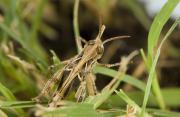The Department of Agriculture and Food has begun surveying for Australian Plague Locusts in the central wheatbelt and is reminding farmers to check paddocks for activity.
Department Invasive Species manager Tim Stevens said targeted surveillance had begun around Merredin and surrounding areas ahead of locust activity predicted across eastern and southern parts of the grainbelt during spring.
“Staff will survey pasture paddocks focusing on potential high density areas first which have been identified from the autumn survey data,” Mr Stevens said.
“The aim of this surveillance is to confirm the accuracy of predictions and provide information to help landholders to make timely decisions on control.”
Landholders are reminded to inspect their properties for locust activity and start preparing for control if necessary.
“Spraying at the right time will help landholders protect their investment in crops and pastures,” Mr Stevens said.
“Spraying locusts is more effective when they are at the nymph stage, before they develop wings.”
Department entomologist Svetlana Micic reminded landholders who had observed locust activity on their properties in autumn to be particularly vigilant, as it was likely there were egg beds which will hatch in spring.
“Pasture paddocks in particular should be checked,” Ms Micic said. “Locusts favour areas of compact, bare soil to lay eggs, including around dam banks, roaded catchments and fencelines.
“If egg beds have been located, these should be monitored regularly. Eggs may hatch simultaneously or over several weeks, depending on conditions.”
Autumn surveys completed by the department indicate moderate density hatchings are likely, which may result in locust bands and loose swarms, in parts of Ravensthorpe, Jerramungup, Gnowangerup, Lake Grace, Kulin, Yilgarn, Westonia, Mukinbudin and Nungarin shires.
Variable hatchings are also likely to occur in other parts of the southern agricultural region and Wheatbelt.
Peak hatchings are expected from mid-September in the central regions and from mid-October in the southern region.
Control this spring will also play a role in limiting potential locust numbers building up over summer and into autumn 2017.
Landholders are encouraged to use the department’s free PestFax Reporter app to report locust activity in spring to assist with mapping locust movements or the department’s Pest and Disease Information Service (PaDIS) on 1800 084 881.
Further information on identification, monitoring and control for locusts is available from the department website agric.wa.gov.au/locusts or call PaDIS.
Fact file:
Pasture risk - Hopper and adult locusts can cause considerable damage to pastures. It is estimated that 20 hoppers per square metre eat the equivalent of three to five sheep per hectare each day.
Crop risk - Crops such as wheat, barley and particularly oats are susceptible to damage from locusts. Crops that are beginning to dry off when locusts begin to fly are susceptible to damage. Even slight damage to grain crops could justify the costs of control.

Media contacts: Jodie Thomson, DAFWA media liaison +61 (0)8 9368 3937
